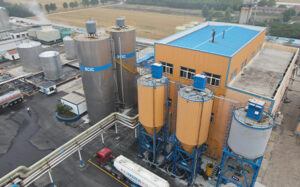Einführung
The paper and pulp industry is a cornerstone of modern society, providing essential materials for various applications. Within this industry, sodium formate, a versatile chemical compound, plays a significant role in enhancing processes and product quality. This article delves into the multifaceted role of sodium formate in the paper and pulp industry, exploring its applications, mechanisms, benefits, and its contribution to sustainable practices.
Verständnis Natriumformiat in Paper and Pulp
Was ist Natriumformiat?
Natriumformiat (HCOONa) is a sodium salt derived from formic acid (HCOOH), known for its white crystalline structure and high water solubility. Its unique properties make it relevant in numerous industries, including the paper and pulp sector.
Sodium Formate’s Functions in Paper and Pulp

1. Cooking Liquor Additive
Natriumformiat serves as an essential additive in the cooking liquor used in the pulping process. It helps control pH levels, aid in the breakdown of lignin, and promote the separation of fibers from wood.
2. Delignification
Sodium formate contributes to the delignification process during pulping. By breaking down lignin, it enhances the separation of fibers, allowing for the production of high-quality pulps with improved properties.
3. Bleaching
In the bleaching process, sodium formate is used as a stabilizing agent for hydrogen peroxide solutions. It helps maintain the stability of the bleaching agent, ensuring consistent and effective bleaching of pulp.
4. Fiber Reinforcement
Sodium formate can improve the strength properties of paper fibers. Its interaction with cellulose fibers during the pulping process enhances fiber bonding and ultimately contributes to higher paper strength.
Mechanisms and Burstiness in Paper and Pulp Applications

1. Delignification Mechanism
Sodium formate’s burstiness in delignification arises from its ability to break down lignin bonds rapidly. As it interacts with lignin, the complex three-dimensional structure of wood is disrupted, leading to the release of fibers.
2. Fiber Bonding Enhancement
The complexity in sodium formate’s role lies in its interactions with cellulose fibers. Its presence promotes hydrogen bonding between fibers, leading to enhanced fiber bonding and paper strength.
Applications of Sodium Formate in Paper and Pulp Industry
1. Pulp Production
Sodium formate’s use in cooking liquor contributes to the efficient separation of fibers during the pulping process. This results in the production of high-quality pulps that can be used to create various paper products.
2. Quality Improvement
The inclusion of sodium formate in the bleaching process helps maintain stable hydrogen peroxide solutions, leading to consistent and effective bleaching. This, in turn, contributes to improved paper quality and brightness.
3. Sustainable Practices
Sodium formate’s role in enhancing the pulping process can lead to reduced chemical usage and more efficient fiber separation. This aligns with sustainable practices by minimizing resource consumption and environmental impact.
Challenges and Future Prospects
1. Optimization of Process Conditions
Achieving optimal process conditions for sodium formate’s usage requires careful calibration. Factors such as dosage, temperature, and pH levels must be fine-tuned to achieve the desired results.
2. Integration with Green Technologies
Continued research is needed to integrate sodium formate’s usage with green technologies and sustainable pulp and paper production methods.
FAQ about Sodium Formate in Paper and Pulp Industry
Q1: Can sodium formate be used with various types of wood?
A1: Sodium formate’s effectiveness may vary with different types of wood. The wood species and their lignin composition can influence the efficiency of the delignification process.
Q2: Is sodium formate environmentally friendly in paper production?
A2: Sodium formate can contribute to more efficient and sustainable pulp production processes. While its usage aligns with environmentally conscious practices, overall environmental impact depends on factors such as process optimization and waste management.
Q3: Does sodium formate affect the properties of the final paper product?
A3: Sodium formate’s contribution to fiber bonding and quality improvement can have a positive impact on the properties of the final paper product, including strength and brightness.
Q4: Are there alternatives to sodium formate in the paper and pulp industry?
A4: Various chemicals and additives are used in the paper and pulp industry for similar purposes. The choice of additive depends on factors such as the specific process, desired outcomes, and economic considerations.
Fazit
Sodium formate’s multifaceted role in the paper and pulp industry underscores its significance in enhancing various processes and product quality. From its contributions to efficient delignification to its role in improving paper strength and brightness, sodium formate’s applications align with the industry’s pursuit of efficiency and sustainability. As the industry continues to evolve, sodium formate’s role may expand, further contributing to the advancement of paper and pulp production practices.


